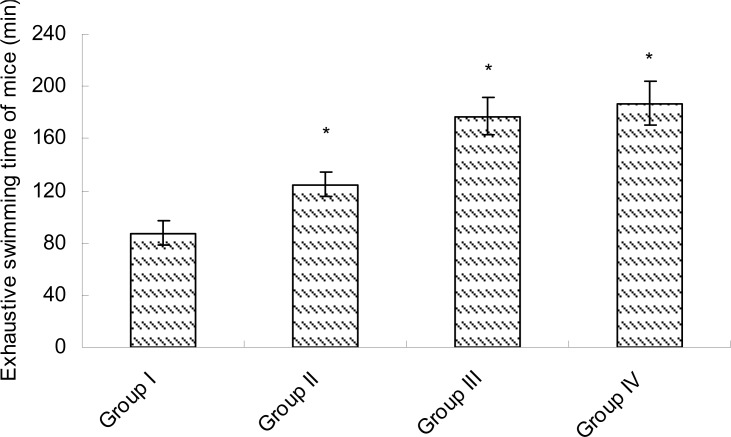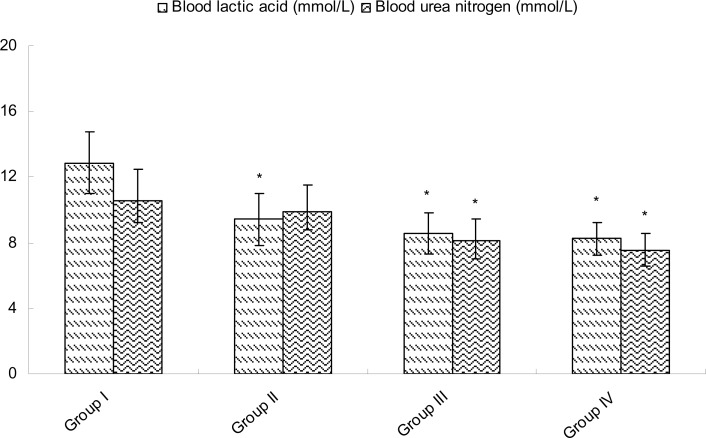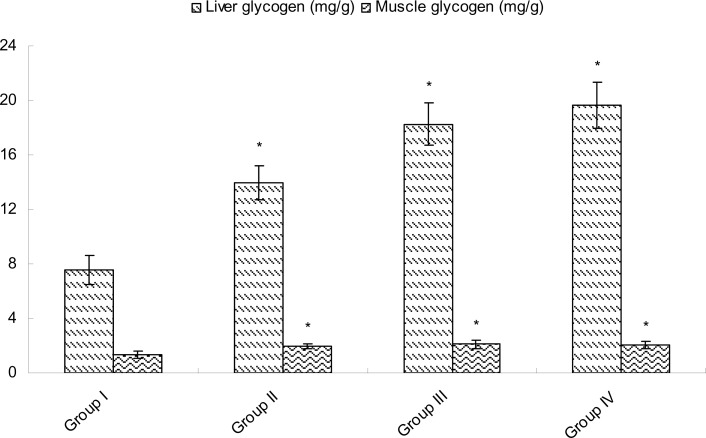Abstract
Tao-Hong-Si-Wu-Tang (THSWT) is a famous traditional Chinese herbal medicine formula, which has traditionally been used in China for about one thousand years. The present study investigated the effect of THSWT on physical fatigue. 32 male mice were randomly divided into 4 groups with 8 in each group. All were administered orally and daily for 28 days. Group I received isotonic saline solution as control; Group II, III and IV obtained 5, 10 and 20ml/ kg body weight of THSWT solutions, respectively. After 28 days, the anti-physical fatigue effect of THSWT was evaluated by using a forced swimming test, along with the determination of blood lactic acid, blood urea nitrogen (BUN), liver glycogen and muscle glycogen contents. The data showed that THSWT could extend exhaustive swimming time of mice, as well as decrease the BLA and BUN contents and increase the liver glycogen and muscle glycogen contents. The results support that THSWT had anti-physical fatigue effect.
Keywords: Tao-Hong-Si-Wu-Tang, physical fatigue, forced swimming test, mice
Introduction
Fatigue is a protective mechanism for animals in response to life threatening over-exhaustion, which can be described as a time-dependent exercise-induced reduction in the maximal force generating capacity of a muscle (Girard et al., 2008; Zheng et al., 2010). The two general types of fatigue are physical fatigue and mental fatigue. Physical fatigue is generally defined as a reduction in capacity to perform physical work as a function of preceding physical effort. Mental fatigue is inferred from decrements in performance on tasks requiring alertness and the manipulation and retrieval of information stored in memory (Lou et al., 2001). Many studies have demonstrated that physical fatigue can limit the body's ability to work and physical performance, and this has become a common universal problem (Kruegera, 1989; Bassett and Howley, 2000; Fu et al., 2010). Since the available therapies for fatigue in modern medicine are very limited, potential alternatives from traditional medicine and their respective mechanisms of action are worth investigating.
Tao-Hong-Si-Wu-Tang (THSWT) is a famous traditional Chinese herbal medicine formula, which has traditionally been used in China for about one thousand years. The formula mainly consists of six plant materials: Shu Di Huang (Rehmannia glutinosa Liboschitz), Bai Shao (Paeonia lactiflora Pallas), Dang Gui (Angelica sinensis (Oliv.) Diels), Chuan Xiong (Ligusticum chuanxiong Hort.), Tao Ren (Prunus persica (L.) Batsch.), and Hong Hua (Carthamus tinctorius L). THSWT has long been employed clinically to promote blood circulation to relieve women's irregular menses disorder, and is also used to treat immunological disorders, migraine, and cardiovascular diseases (CVDs) such as hypertension and angina (Huang, 2006). Furthermore, it can increase blood flow of the microcirculation thereby regulating diabetic neuropathies and glucocorticoid-induced avascular necrosis of the femoral head (Wu et al., 2011). In addition, THSWT is traditionally used as folk remedy in the treatment of physical and mental fatigue in the southern part of China. However, there are no scientific reports to support the anti-fatigue property of THSWT. The purpose of the present study was to determine the effect of THSWT on physical fatigue in mice based on scientific data.
Materials and Methods
Plant materials
Shu Di Huang (Rehmannia glutinosa Liboschitz), Bai Shao (Paeonia lactiflora Pallas), Dang Gui (Angelica sinensis (Oliv.) Diels), Chuan Xiong (Ligusticum chuanxiong Hort.), Tao Ren (Prunus persica (L.) Batsch.), and Hong Hua (Carthamus tinctorius L.) were purchased from the local herbal shop (Chengdu, China) and identified by Dr. MF Li, Botanist of Sichuan University (Chengdu, China), and all the voucher specimens (Voucher number SS064, SS857, SS263, SS571) were deposited at the Institute of Chinese Medical Sciences , Sichuan University.
Reagents
The kits (special for animal testing) of blood lactic acid (BLA), blood urea nitrogen (BUN) and glycogen were purchased from the Jianchen Bioengineering Institute (Nanjing, China). Other chemicals and biochemicals were of analytical grade and were purchased from Sigma Chem. Co. (St. Louis, MO, USA) and Changsheng Pharmaceutical. Co. (Chengdu, China) unless otherwise indicated.
Animals
Male Kun-Ming strain mice weighing 20 ± 2 g were obtained from Sichuan Research Animal Center (Chengdu, China). The animals were housed in a room maintained at 24–26 °C with a normal day/night cycle. Mice were provided with a basal diet (purchased from Sichuan Research Animal Center) and free access to drinking water. All animals received humane care according to the guideline of Guidebook for the Care and Use of Laboratory Animals. The study protocol was approved by the animal research ethics committee at Sichuan University (Chengdu, China).
Preparation of THSWT solutions
THSWT solutions were prepared by decocting the dried prescription of herbs with boiling water. After the first decoction, the duration of which was about 30 min, the suspension was filtered and water was added for the second decoction, the duration of which was about 20 min. The filtered and mixed suspension from two decoction was condensed to the concentration of 1 g dried herb weight/ml solution and then stored at −20 °C before administration. The ingredients of 63 g THSWT included 15 g of Shu Di Huang, 10 g of Bai Shao, 15 g of Dang Gui, 8 g of Chuan Xiong, 9 g of Tao Ren and 6 g of Hong Hua.
Animals grouping and treatment
32 male mice were randomly divided into 4 groups with 8 in each group. All were administered orally and daily for 28 days. Group I received isotonic saline solution as control; Group II, III and IV obtained 5, 10 and 20ml/ kg body weight of THSWT solutions, respectively. The mice were made to swim for 15 min three times a week to accustom them to swimming. After 28 days, the mice were submitted to a forced swimming test to determine the effect of THSWT on physical fatigue.
Forced swimming test
The physical fatigue was induced by forcing animals to swim until exhaustion. The mice were placed in a tank filled with fresh water (approximately 30 cm deep). Water temperature was maintained at 25 ± 1 °C. The mice were loaded with a steel washer weighing approximately 5% of their body weight attached to the tails. Exhaustion was determined by observing loss of coordinated movements and failure to return to the surface within 7 s (Wu et al., 1998). This 7 s criterion was considered to correlate with exhaustion, and was used as an indication of the maximum swimming capacity of the animal (Jung et al., 2004; Wang et al., 2010; Wang and Yan, 2010). Mice were removed at this point, before drowning.
Biochemical parameters assay
After the forced swimming test, the mice were taken out and the blood were collected through eyeballs to prepare the serum for use, while the liver and gastrocnemius muscle were collected to be made into 10% homogenates with normal saline at 4 °C as soon as possible. Several biochemical parameters, such as blood lactic acid, BUN, liver glycogen and muscle glycogen, were determined.
Statistical analysis
The data are expressed as means ± S.D. Statistical comparisons were compared by one-way analysis of variance (ANOVA). The results were considered statistically significant if the p values were 0.05 or less.
Results
THSWT prolonged the exhaustive swimming time of mice
Figure 1 shows the effect of THSWT on the exhaustive swimming time of mice. The exhaustive swimming times of mice in the Group II, III and IV were significantly prolonged compared with that in the Group I (p < 0.05), which is 1.42, 2.02 and 2.14 times longer than that in the control group, respectively.
Figure 1.
The effect of Tao-Hong-Si-Wu-Tang (THSWT) on the exhaustive swimming time of mice
Values are mean ± S.D., Group I: control group; Group II: 5 ml/ kg bweight THSWT treated group; Group III: 10 ml/ kg body weight THSWT treated group; Group IV: 20 ml/ kg body weight THSWT treated group. * p < 0.05 compared with Group I.
THSWT decreased blood lactic acid and blood urea nitrogen contents after exhaustive swimming
Figure 2 shows the effect of THSWT on the BLA and BUN of mice after exhaustive swimming. The BLA contents of mice in the Group II, III and IV were significantly decreased compared with that in the Group I (p < 0.05). The BUN contents of mice in the Group III and IV were significantly decreased compared with that in the Group I (p < 0.05). Although the BUN contents of mice in Group II were also increased, no significant difference was observed (p > 0.05).
Figure 2.
The effect of Tao-Hong-Si-Wu-Tang (THSWT) on the BLA and BUN of mice after exhaustive swimming Values are mean ± S.D., Group I: control group; Group II: 5 ml/ kg bweight THSWT treated group; Group III: 10 ml/ kg body weight THSWT treated group; Group IV: 20 ml/ kg body weight THSWT treated group.* p < 0.05 compared with Group I.
THSWT increased liver glycogen and muscle glycogen contents of mice after exhaustive swimming
As shown in Figure 3, after exhaustive swimming, the liver glycogen and muscle glycogen contents of mice in the Group II, III and IV were significantly increased compared with that in the Group I (p < 0.05).
Figure 3.
The effect of Tao-Hong-Si-Wu-Tang (THSWT) on the liver glycogen and muscle glycogen of mice after exhaustive swimming
Values are mean ± S.D., Group I: control group; Group II: 5 ml/ kg bweight THSWT treated group; Group III: 10 ml/kg body weight THSWT treated group; Group IV: 20 ml/ kg body weight THSWT treated group.* p < 0.05 compared with Group I.
Discussion
Fatigue is one of the most frequent physiological reactions. It often occurs in aging, cancer, depression, HIV infection, multiple sclerosis and Parkinson's disease (Tharakan et al., 2006). Many reports have indicated that some traditional Chinese herbal medicine formula, such as Jian-Li-Fang, Liu-Wei-Di-Huang-Tang, Kai-Xin-San and Shi-Quan-Da-Bu-Tang etc, which not only can postpone fatigue and accelerate the elimination of fatigue in human beings, but also have few side effects (Wang et al., 2005; Li and Wei, 2005; Wu et al., 2011). However, as far as we know, the anti-fatigue activity of Tao-Hong-Si-Wu-Tang (THSWT) is still poorly understood. Therefore, the present study is to investigate the effect of THSWT, a traditional Chinese herbal medicine formula, on physical fatigue-induced stress models in mice, which would provide scientific evidence for traditional Chinese herbal medicine formula for prevention and treatment of diseases related to fatigue.
The forced swimming test has been used to evaluate the anti-fatigue effect of medicine, since this apparatus works well for evaluating the endurance capacity of mice and gives a high reproducibility (Nozawa et al., 2009). In this study, the data showed that THSWT significantly prolonged exhaustive swimming time of mice, which indicated that THSWT could elevate the exercise tolerance and possessed an anti-physical fatigue effect.
Blood lactate acid (BLA) is the glycolysis product of carbohydrate under an anaerobic condition, and glycolysis is the main energy source for intense exercise in a short time. Therefore, the blood lactate acid is one of the important indicators for judging the degree of fatigue (Gandevia, 2001; Wang et al., 2006). In this study, the data showed that THSWT significantly decreased BLA contents of mice after exhaustive swimming, which indicated that THSWT could effectively retard and lower the blood lactic produced, and ultimately improve endurance capacity and postpone the appearance of physical fatigue. Serum urea nitrogen (SUN), the metabolic outcome of protein and amino acid, is a sensitive index to evaluate the bearing capability when body suffered from a physical load. In other words, the worse the body is adapted to exercise tolerance, the more significantly the SUN level increases (Zhang et al., 2006; Huang et al., 2011). So, SUN was measured as another index of fatigue. In this study, the data showed that middle and high dose of THSWT significantly decreased BLA contents of mice after exhaustive swimming, which indicated that THSWT reduced the decomposition of nitrogenous substances in the body and improved endurance capacity during exercise.
The glycogen contents are sensitive parameters related to fatigue, hence the liver and muscle tissues were used for its glycogen content. It is known that endurance capacity decreases if the available energy is exhausted. Glycogen is the important resource of energy during exercise, the increase in glycogen stored in liver is an advantage to enhance the physical endurance (Madsen et al., 1990). Depletion of liver glycogen is an important factor in the exercised fatigue, which may lead to hypoglycemia impairing nervous function (Shang et al., 2009; Jin and Wei, 2011). In this study, the data showed that THSWT significantly increased liver glycogen and muscle glycogen contents of mice after exhaustive swimming, which indicated that THSWT possessed the glycogen sparing action. The results showed that the anti-physical fatigue effect of THSWT might be related to the improvement in the metabolic control of exercise and the activation of energy metabolism (Wang et al., 2006).
Conclusion
In this study, the data showed that THSWT could extend exhaustive swimming time of mice, as well as decrease the BLA and BUN contents and increase the liver glycogen and muscle glycogen contents. The results supported that THSWT had anti-physical fatigue effect. Further study is necessary to better understand the mechanism involved in the action of THSWT on physical fatigue, and to assess the optimum dose.
Acknowledgements
This work was supported by the Sichuan university cross-disciplinanary research projects (No.SKQY201109)
References
- 1.Bassett DR, Howley ET. Limiting factors for maximum oxygen uptake and determinants of endurance performance. Med Sci Sports Exerc. 2000;32:70–84. doi: 10.1097/00005768-200001000-00012. [DOI] [PubMed] [Google Scholar]
- 2.Fu X, Ji R, Dam J. Antifatigue effect of coenzyme Q10 in mice. J Med Food. 2010;13:211–215. doi: 10.1089/jmf.2009.0049. [DOI] [PubMed] [Google Scholar]
- 3.Gandevia SC. Spinal and supraspinal factors in human muscle fatigue. Physiol Rev. 2001;81:1725–1789. doi: 10.1152/physrev.2001.81.4.1725. [DOI] [PubMed] [Google Scholar]
- 4.Girard O, Lattier G, Maffiuletti NA, Micallef JP, Millet GP. Neuromuscular fatigue during a prolonged intermittent exercise: Application to tennis. J Electromyogr Kinesiol. 2008;18:1038–1046. doi: 10.1016/j.jelekin.2007.05.005. [DOI] [PubMed] [Google Scholar]
- 5.Huang LZ, Huang BK, Ye Q, Qin LP. Bioactivity-guided fractionation for anti-fatigue property of Acanthopanax senticosus. J Ethnopharmacol. 2011;133:213–219. doi: 10.1016/j.jep.2010.09.032. [DOI] [PubMed] [Google Scholar]
- 6.Huang XP. Report on essential hypertension (51 cases) treated by differentiation of symptoms and signs. J Practic Traditi Chin Med. 2006;2:68–69. [Google Scholar]
- 7.Jin HM, Wei P. Anti-fatigue properties of tartary buckwheat extracts in mice. Int J Mol Sci. 2011;12:4770–4780. doi: 10.3390/ijms12084770. [DOI] [PMC free article] [PubMed] [Google Scholar]
- 8.Jung K, Kim IH, Han D. Effect of medicinal plant extracts on forced swimming capacity in mice. J Ethnopharmacol. 2004;93:75–81. doi: 10.1016/j.jep.2004.03.022. [DOI] [PubMed] [Google Scholar]
- 9.Kruegera GP. Sustained work, fatigue, sleep loss and performance: A review of the issues. Work Stress. 1989;3:129–141. [Google Scholar]
- 10.Li RW, Wei CL. Experiment of Chinese herbal jian li fang on antikinetic fatigue. Chin J Clin Rehabil. 2005;9:236–238. [Google Scholar]
- 11.Lou JS, Kearns G, Oken B, Sexton G, Nutt J. Exacerbated physical fatigue and mental fatigue in Parkinson's disease. Mov Disord. 2001;16:190–196. doi: 10.1002/mds.1042. [DOI] [PubMed] [Google Scholar]
- 12.Madsen K, Pedersen PK, Rose P, Richter EA. Carbohydrate supercompensation and muscle glycogen utilization during exhaustive running in highly trained athletes. Eur J Appl Physiol Occup Physiol. 1990;61:467–472. doi: 10.1007/BF00236069. [DOI] [PubMed] [Google Scholar]
- 13.Nozawa Y, Yamada K, Okabe Y, Ishizaki T, Kuroda M. The anti-fatigue effects of the low-molecular-weight fraction of bonito extract in mice. Biol Pharm Bull. 2009;32:468–474. doi: 10.1248/bpb.32.468. [DOI] [PubMed] [Google Scholar]
- 14.Shang H, Cao S, Wang J, Zheng H, Putheti R. Glabridin from Chinese herb licorice inhibits fatigue in mice. Afr J Tradit Complement Altern Med. 2009;7:17–23. doi: 10.4314/ajtcam.v7i1.57225. [DOI] [PMC free article] [PubMed] [Google Scholar]
- 15.Tharakan B, Dhanasekaran M, Brown-Borg HM, Manyam BV. Trichopus zeylanicus combats fatigue without amphetamine-mimetic activity. Phytother Res. 2006;20:165–168. doi: 10.1002/ptr.1773. [DOI] [PubMed] [Google Scholar]
- 16.Wang J, Li S, Fan Y, Chen Y, Liu D, Cheng H, Gao X, Zhou Y. Anti-fatigue activity of the water-soluble polysaccharides isolated from Panax ginseng C. A. Meyer. J Ethnopharmacol. 2010;130:421–423. doi: 10.1016/j.jep.2010.05.027. [DOI] [PubMed] [Google Scholar]
- 17.Wang J, Liu P, Chen M, Wang D, Yu J, Xing J, Yan J. Effect of Kaixin Powder on central neurotransmitter and plasma cortisol in forced-swimming mice. J Beijing Univ Tradit Chin Med. 2005;2:84–87. [Google Scholar]
- 18.Wang JJ, Shieh MJ, Kuo SL, Lee CL, Pan TM. Effect of red mold rice on antifatigue and exercise-related changes in lipid peroxidation in endurance exercise. Appl Microbiol Biotechnol. 2006;70:247–253. doi: 10.1007/s00253-005-0051-5. [DOI] [PubMed] [Google Scholar]
- 19.Wang ZB, Yan B. Gastrodia elata Blume extract ameliorates exercise-induced fatigue. Afr J Biotech. 2010;9:5978–5982. [Google Scholar]
- 20.Wu CJ, Chen JT, Yen TL, Jayakumar T, Chou DS, Hsiao G, Sheu JR. Neuroprotection by the Traditional ChineseMedicine, Tao-Hong-Si-Wu-Tang, againstMiddle Cerebral Artery Occlusion-Induced Cerebral Ischemia in Rats. Vol. 10. Hindawi Publishing Corporation; 2011. pp. 1–9. [DOI] [PMC free article] [PubMed] [Google Scholar]
- 21.Wu YB, Zhang YH, Wu JA, Lowell TS, Gu MJ, Yuan CS. Effects of Erkang, a modified formulation of Chinese folk medicine Shi-Quan-Da-Bu-Tang, on mice. J Ethnopharmacol. 1998;61:153–159. doi: 10.1016/s0378-8741(98)00027-0. [DOI] [PubMed] [Google Scholar]
- 22.Yang JM. Therapeutic effect observation of 154 cases of coronary artery disease angina using Tao-hong-si-wu-tang (THSW) Chin J Mod Med. 2007;17:2268–2275. [Google Scholar]
- 23.Zhang Y, Yao X, Bao B, Zhang Y. Anti-fatigue activity of a triterpenoid-rich extract from Chinese bamboo shavings (Caulis bamfusae in taeniam) Phytother Res. 2006;20:872–876. doi: 10.1002/ptr.1965. [DOI] [PubMed] [Google Scholar]
- 24.Zheng SQ, Jiang F, Gao HY, Zheng JG. Preliminary observations on the antifatigue effects of longan (Dimocarpus longan Lour.) seed polysaccharides. Phytother Res. 2010;24:622–624. doi: 10.1002/ptr.2963. [DOI] [PubMed] [Google Scholar]





